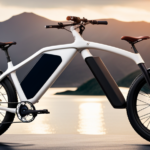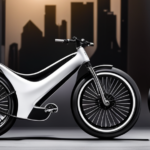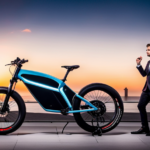Choosing between a 36V and 48V e-bike system depends on your riding needs. A 36V setup is lighter, more affordable, and ideal for flat city streets, offering good energy efficiency. A 48V system provides more power, faster acceleration, and better performance on hills and rough terrains. If you want to explore different terrains or need extra speed and torque, a 48V might suit you better. Continue to discover how each option can maximize your riding experience.
Key Takeaways
- 48V systems deliver higher voltage, resulting in increased power, torque, and better performance on hills compared to 36V systems.
- 36V e-bikes are lighter, more affordable, and more suitable for urban flat terrain riding.
- 48V batteries typically provide more watt-hours, offering greater range and responsiveness in demanding conditions.
- 36V setups are generally more energy-efficient for flat terrain and easier to upgrade or replace.
- Compatibility and cost are important; 48V systems require specific components and tend to be more expensive initially.
Understanding the Basics of Battery Voltage and Its Role in E-Bike Performance
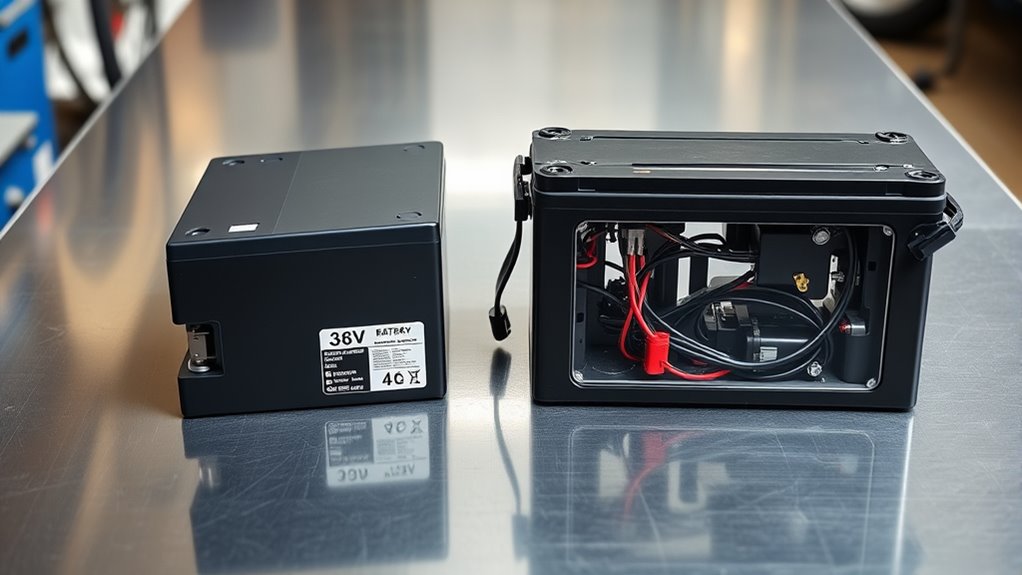
Understanding battery voltage is key to grasping how your e-bike performs. The battery’s voltage indicates the electrical potential difference, directly affecting the power sent to your motor. A higher voltage, like 48V, provides more force, boosting performance in acceleration, top speed, and hill climbing. It also influences range, as it determines how much energy the battery can supply, especially when combined with capacity in amp-hours to calculate watt-hours. Lower voltage batteries, such as 36V, deliver less power but may offer longer battery life in some cases. Ensuring the right voltage matches your motor and controller is essential for ideal efficiency, ensuring your e-bike runs smoothly and reliably. Additionally, consistent storytelling can help you understand how to select the best system for your needs. Understanding battery capacity is also important, as it impacts how long you can ride before needing a recharge. Moreover, matching your battery voltage with your motor specifications ensures optimal system performance and avoids potential damage. Properly matching voltage and other specifications can also influence the overall safety and durability of your e-bike.
Key Differences Between 36V and 48V Batteries in Electric Bikes
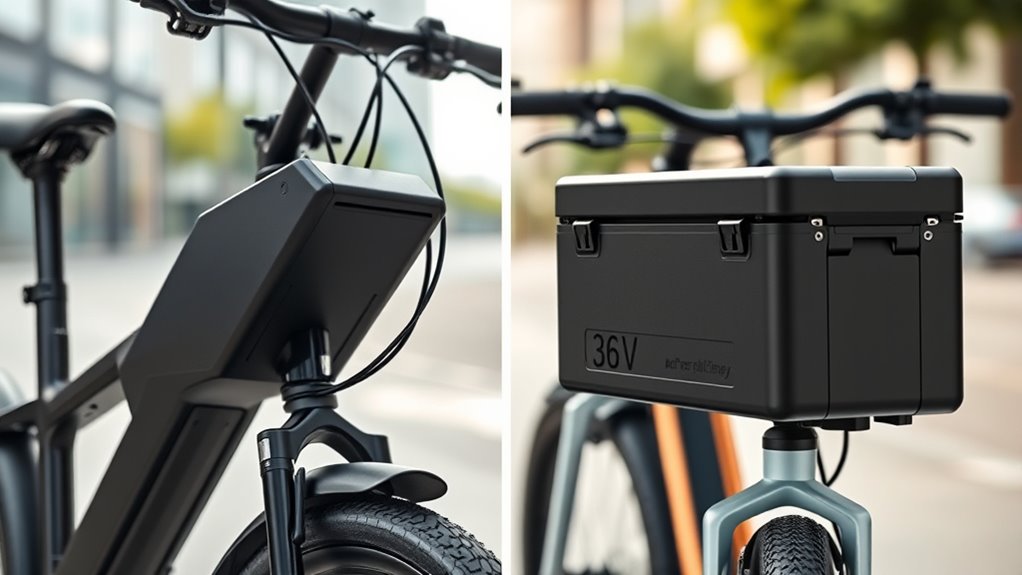
A 48V battery delivers roughly 33% more voltage than a 36V battery, which translates into increased power and torque for your e-bike. This higher voltage enhances overall performance, offering better acceleration and efficiency, especially on challenging terrain like hills or off-road trails. You’ll notice higher top speeds, typically between 20-28 mph, compared to 15-20 mph with a 36V system. The increased voltage also allows for greater battery capacity and longer range, so you can ride farther without recharging. Compatibility with motors and potential for performance upgrades are improved with a 48V system, giving you more flexibility. Additionally, choosing the right voltage can influence your projector image quality, ensuring a more immersive riding experience. When selecting a system, consider not only the performance benefits but also the overall weight and cost, which are generally higher for 48V batteries. However, keep in mind that 36V batteries are generally lighter and more affordable, making them ideal for urban commuting and casual riding. Moreover, understanding the battery voltage differences can help you make more informed decisions for your e-bike setup, especially when considering tuning options for optimizing performance.
Impact of Voltage on Speed, Power, and Riding Experience
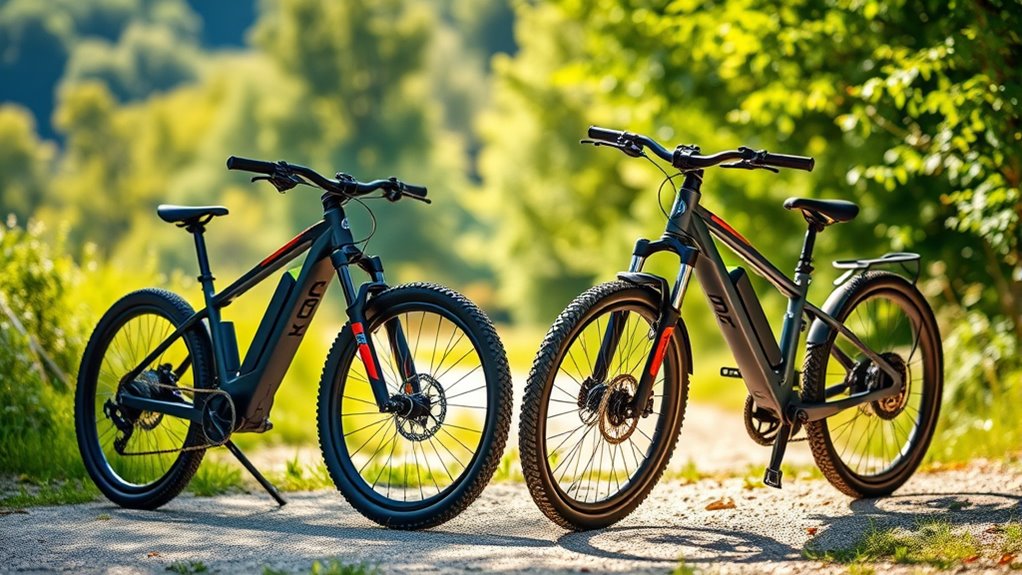
Higher voltage in e-bikes directly boosts power, resulting in quicker acceleration and stronger torque. With 48V systems, you’ll notice better motor capacity, giving you more confidence in hill climbing and rough terrain. The voltage impact means faster acceleration and improved performance, especially on steep inclines. While both 36V and 48V bikes reach 25 km/h on flat terrain, 48V models tend to be slightly quicker on hills, enhancing your riding experience. The increased power output enhances bike handling in challenging conditions, making your ride smoother and more responsive. Additionally, the federated relationship between voltage and overall performance underscores the importance of choosing the right system for your riding needs. Here’s a quick comparison:
| Voltage | Max Speed on Flat | Hill Climbing | Torque | Overall Performance |
|---|---|---|---|---|
| 36V | 25 km/h | Moderate | Lower | Basic |
| 48V | 25 km/h | Better | Higher | Enhanced |
Range, Capacity, and How Voltage Influences Distance
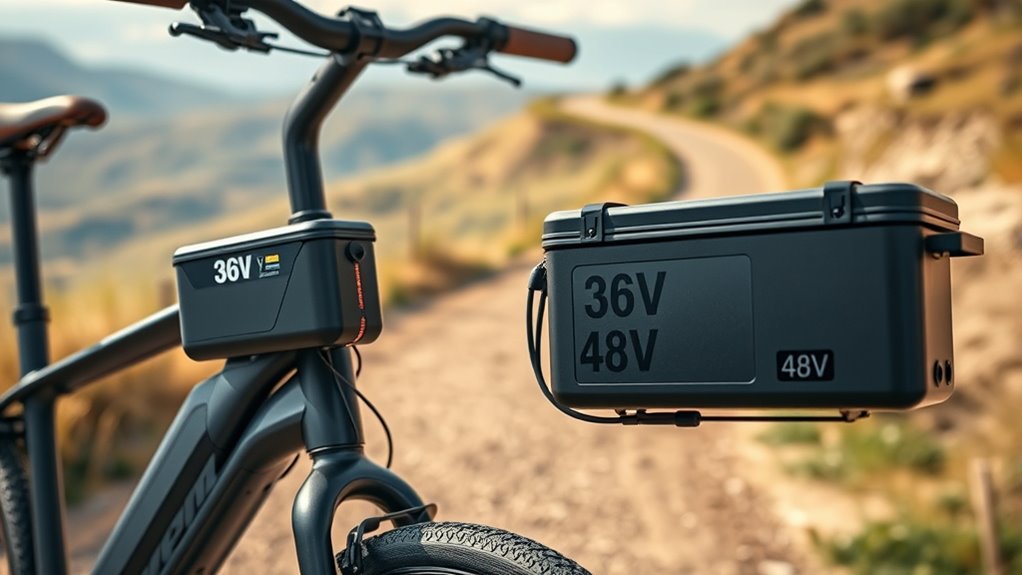
Since higher voltage boosts power and acceleration, it also influences how far you can ride on a single charge. Voltage affects the overall energy storage, measured in watt-hours (Wh), which directly impacts your range. A higher voltage battery, like 48V, combined with the same capacity (Ah), provides more watt-hours—meaning more energy for longer distances. For example, a 36V battery with 10Ah offers 360Wh, while a 48V battery with the same capacity supplies 480Wh, extending your potential range. Increasing voltage while maintaining capacity boosts watt-hours, enhancing e-bike performance and allowing you to cover greater distances. Ultimately, voltage influences range indirectly by shaping the total energy stored, enabling longer rides if battery capacity is scaled accordingly. Additionally, understanding voltage impact helps optimize your riding experience by balancing power, weight, and range, especially when considering battery chemistry and its effect on longevity. It’s also important to consider charger compatibility to ensure safe and efficient charging of higher-voltage systems. Proper battery management practices further ensure optimal performance and lifespan of the e-bike system.
Considerations of Weight, Portability, and Compatibility
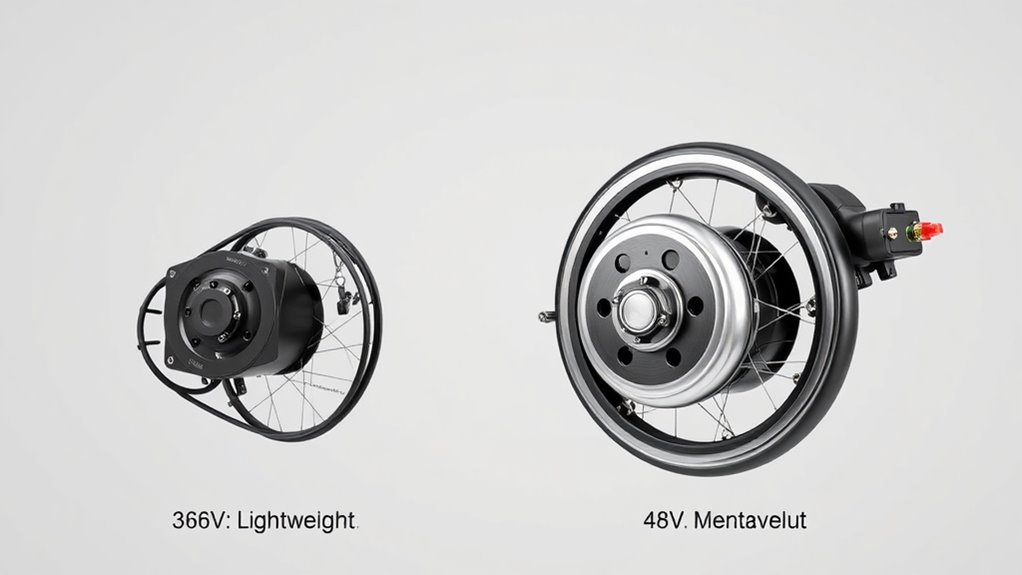
When choosing between 36V and 48V batteries, weight and portability become key factors to contemplate. 36V batteries are lighter, typically weighing 3-5 kg, making them easier to carry and handle. In contrast, 48V batteries are heavier, around 4-6 kg, which can impact your bike’s handling and transport ease. The increased battery weight of 48V models may require more effort when lifting or storing your bike. Compatibility is also vital; higher voltage systems often need specific controllers and motors designed for 48V, complicating upgrading options from 36V. If portability and ease of handling matter most, 36V batteries offer a clear advantage. However, verify your motor and controller are compatible before considering an upgrade to 48V to avoid potential compatibility issues. Additionally, understanding hybrid bike features can help you better assess how different battery systems integrate with your overall cycling setup.
Cost Implications and Upgradability of 36V vs. 48V Systems
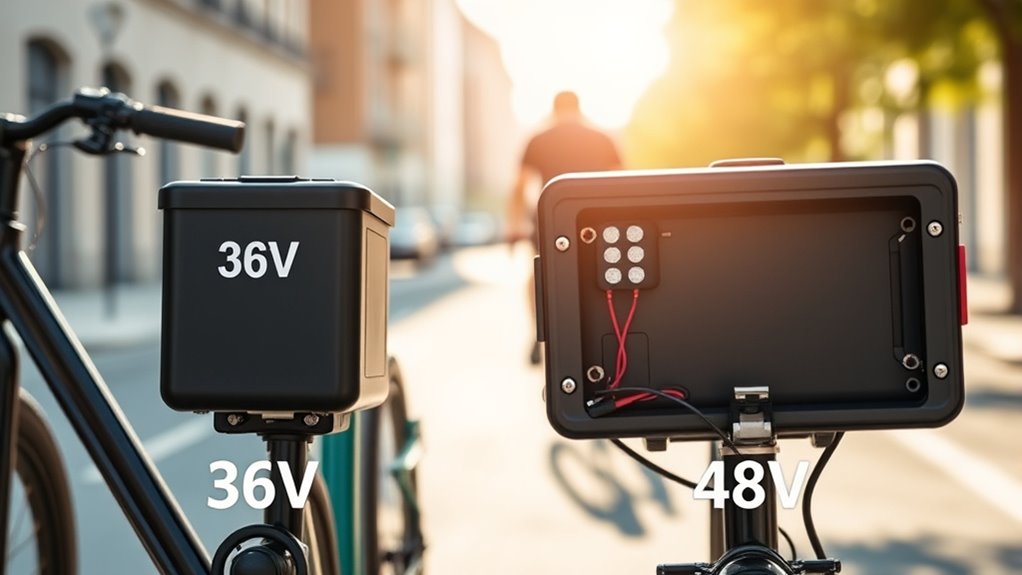
Opting for a 36V system generally means spending less upfront, as these batteries and components tend to be more affordable for budget-conscious riders. However, this lower initial investment may limit your system’s upgradability and performance potential. Upgrading from 36V to 48V can be complex and costly, often requiring new batteries, controllers, motors, and significant modifications.
Consider the emotional impact:
- Feel confident knowing your initial cost is lower.
- Embrace the ability to upgrade without major expenses.
- Avoid costly compatibility issues with existing components.
- Experience smoother performance with higher voltage systems.
- Invest smartly for long-term riding enjoyment.
While 48V systems cost more initially, they open doors for future upgrades and better performance, making them a more flexible choice for long-term riders.
Selecting the Ideal Battery Voltage Based on Riding Needs and Terrain
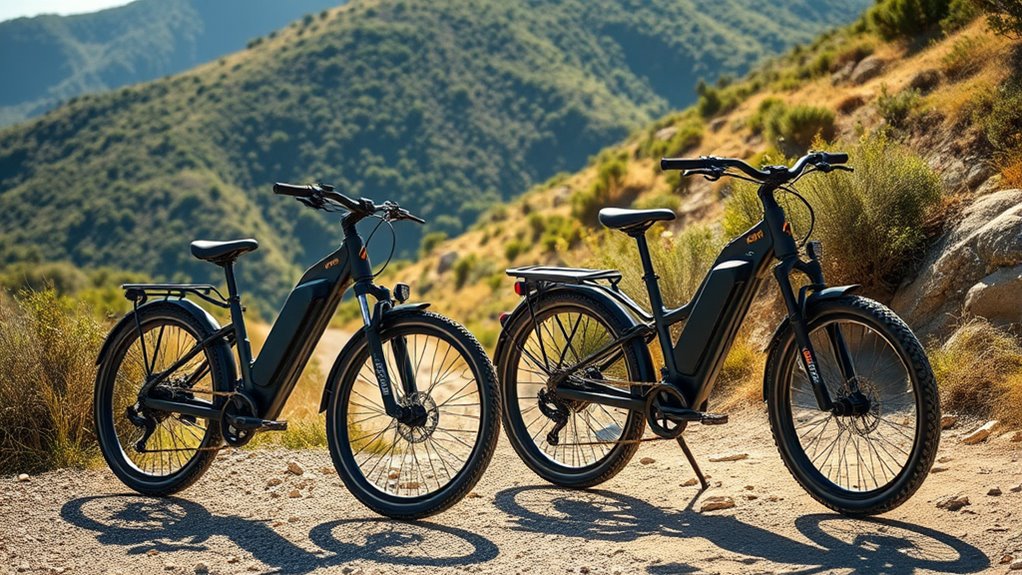
Choosing the right battery voltage depends heavily on your riding environment and performance goals. If you frequently tackle hilly terrains or need higher power output for demanding rides, a 48V battery is ideal. It offers increased torque and acceleration, supporting more powerful motors and better performance for challenging terrain. On the other hand, if your rides are mostly urban commuting on flat roads, a 36V battery provides sufficient power, offering better range and energy efficiency. This setup suits riders aiming for longer ride distances and smoother performance in city environments. Additionally, considering vertical storage solutions can help manage battery and accessory storage more effectively. Proper battery management can also extend the lifespan of your e-bike system. For those seeking optimal performance optimization, understanding the balance between voltage and other system components is crucial. Optimizing system compatibility can enhance overall riding experience and component longevity. Additionally, a proper understanding of power requirements helps in selecting the most suitable voltage for your specific riding conditions. Ultimately, your choice should reflect your typical terrain, desired speed, and performance needs. Selecting the appropriate battery voltage ensures superior performance, ride comfort, and energy use tailored to your specific riding style.
Frequently Asked Questions
Is 36V or 48V Better for an Ebike?
You want to know which system is better for your e-bike. If you prioritize affordability, lighter weight, and urban commuting, a 36V system suits you well. But if you’re after higher speeds, better torque, and tackling hills or long rides, a 48V system is the better choice. Consider your riding style and terrain to decide which voltage matches your needs for a more satisfying riding experience.
Can You Replace a 36V Battery With a 48V Battery on an E-Bike?
You can substitute a 36V battery with a 48V one if it fits your e-bike’s battery compartment. However, you need to verify if your motor and controller are compatible with the higher voltage. Using a 48V battery on a 36V system without modifications can cause damage or safety issues. Always consult your bike’s manufacturer or a professional technician to ensure a safe, proper upgrade.
What Voltage Is Best for Ebikes?
You might wonder which voltage suits you best. If you’re after a smooth, affordable ride for city commutes or leisure, a 36V system fits well. But if you crave more power, faster speeds, or tackle tough hills, a 48V setup is your go-to. Think about your riding style and terrain—matching voltage to your needs guarantees you receive the best performance, safety, and enjoyment from your e-bike.
How Long Does a 36 Volt Ebike Battery Last?
A 36V e-bike battery typically lasts between 2 to 5 years, depending on how well you care for it and the number of charge cycles. Each full charge usually provides 20 to 30 miles, influenced by your riding style and terrain. Proper maintenance, like avoiding extreme temperatures and regular charging, can help extend its lifespan, ensuring you get the most out of your battery over time.
What Is the Difference Between 36V 10AH and 48V 10AH?
Think of the batteries as two engines—one a bit smaller, one more powerful. The 36V 10Ah offers decent performance and lighter weight, like a nimble skateboard. The 48V 10Ah pushes more energy and power, like a turbocharged car. Both have the same capacity in amp-hours, but the 48V version stores more watt-hours, giving you longer rides and faster acceleration. Choose based on whether you want lightness or extra performance.
Conclusion
Choosing between 36V and 48V e-bike systems depends on your riding style and terrain. If you prefer faster speeds and more power, 48V might be your best bet—studies show it can boost top speeds by up to 20%. However, consider weight and range needs too. Ultimately, understanding these differences helps you pick the right system for your adventures, ensuring you enjoy a smooth, efficient ride every time.


